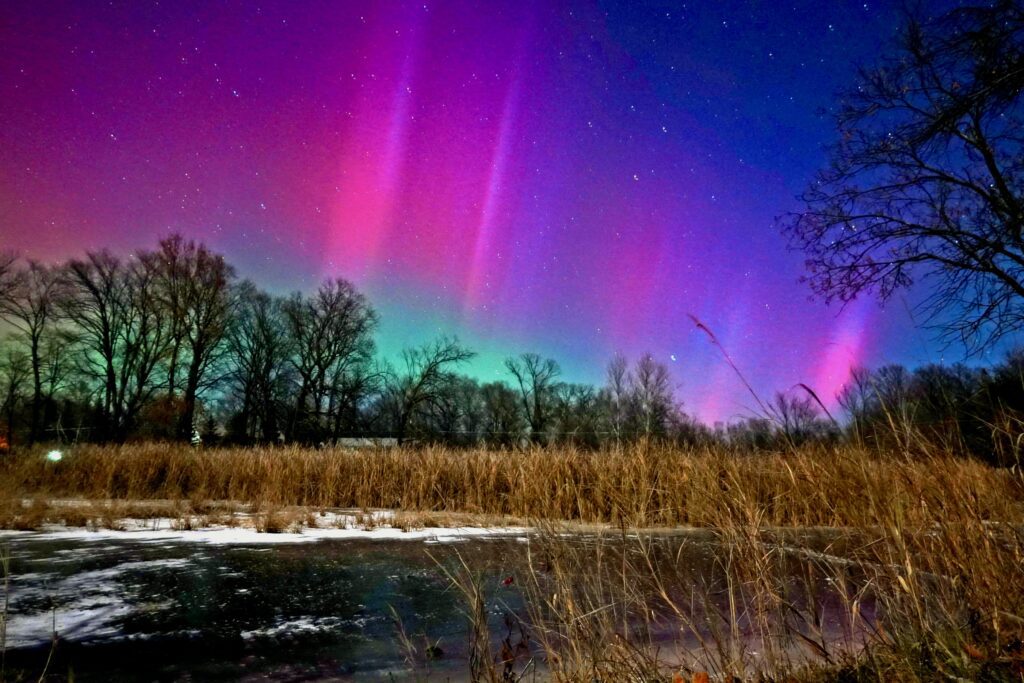

A Celestial Ballet Painted Across the Minnesota Night Sky
Imagine the night sky as a vast canvas, sprinkled with diamonds and dusted with starlight. But wait – a whisper, an emerald streak ignites the horizon, followed by a cascade of green or violet twirls. The Aurora Borealis has arrived, a celestial ballet painted across the heavens just for your eyes. Forget the icy grip of the Arctic Circle – Mille Lacs Lake offers a hidden gem experience in Minnesota where you’re not just a spectator; you’re front-row center to this cosmic performance.


The Science Behind the Whispers: Earth’s Cosmic Dance Floor
The mesmerizing dance of the Aurora Borealis, also known as the Northern Lights, is not just a spectacle to behold; it’s a cosmic phenomenon with a fascinating scientific explanation. The journey begins with the sun, our celestial powerhouse, constantly releasing a stream of charged particles called the solar wind. These tiny particles travel at incredible speeds, some reaching up to 1,500 miles per second.
As these solar particles journey towards Earth, they encounter our planet’s magnetic shield, a protective barrier created by Earth’s rotating iron core. Most solar particles are deflected by this magnetic shield. Still, some of the most determined, known as magnetospheric electrons, manage to slip through.
These magnetospheric electrons spiral toward Earth’s poles, guided by the magnetic field lines. As they approach, they collide in the upper atmosphere with gas molecules, primarily oxygen and nitrogen. This collision excites the gas molecules, causing them to release energy in the form of light. The color of the light emitted depends on the type of gas molecule involved. Oxygen produces the familiar green and red hues, while nitrogen emits a more subtle blue or purple glow.
The intensity of the aurora varies depending on several factors, including solar activity, geomagnetic conditions, and atmospheric conditions. The most intense auroras, known as solar storms, occur during high solar activity. These storms can cause the aurora to dance across the sky, even in regions far from the poles.
Witnessing the Aurora Borealis is a truly awe-inspiring experience, a reminder of the interconnectedness of our planet and the cosmos. So, bundle up, grab your camera, and venture into the crisp night air of Mille Lacs Lake. Let the whispers of the Aurora Borealis wash over you, and witness the magic unfold before your eyes.
Chasing the Whispers: A Stargazer’s Guide to Mille Lacs
As the sun dips below the horizon, casting long shadows across the landscape, a hush falls over Lake Mille Lacs. The stars emerge, twinkling like diamonds scattered across a velvet cloth. And then, a whisper – an emerald streak ignites the northern sky, followed by a cascade of violet twirls. The Aurora Borealis has arrived, a celestial ballet painted across the heavens just for your eyes.
Mille Lacs Lake offers a variety of prime locations to witness this cosmic spectacle. For unobstructed views of the dancing lights, head to Twilight Rd, where the vast expanse of the lake stretches out before you, providing a mesmerizing backdrop to the aurora’s performance.
If you prefer a cozier setting, the channel behind Sunset Shore Mille Lacs offers a tranquil haven for stargazing in the heart of Minnesota. As the aurora paints the sky with its vibrant hues, settle in, grab your thermos of hot chocolate, and let the whispers wash over you. This is a moment to be cherished, a memory to be etched forever in your heart.




Deciphering the Cosmic Whispers: Tools for Aurora Prediction
While predicting the aurora with absolute certainty is akin to solving the whispers of the wind, there are tools to help us anticipate the likelihood and intensity of this celestial spectacle. Here are three key indicators to keep an eye on:
- KP Index: The KP index is a global measure of geomagnetic activity, ranging from 0 to 9. The higher the KP index, the stronger the geomagnetic disturbance and the greater the likelihood of auroral activity. When the KP index reaches 5 or higher, prepare for a show-stopping aurora borealis display.
- Bz: Bz is a component of the Earth’s magnetic field that points northward or southward. When Bz turns southward, it allows more solar particles to enter Earth’s atmosphere, increasing the chances of auroral activity. A negative Bz value below -5 for around 30-60 minutes indicates an ideal condition for the aurora to charge up and ignite the night sky.
- Auroral Oval: The auroral oval is a doughnut-shaped region around the Earth’s magnetic poles where the aurora is most likely to occur. Tracking the movement and intensity of the auroral oval can help you pinpoint the exact location where the aurora is putting on its most dazzling performance.
In addition to these critical indicators, weather conditions can also influence auroral visibility. Clear skies are essential for optimal viewing, as clouds can obstruct the view of the dancing lights. Check local weather forecasts to ensure your aurora-chasing adventure is not hindered by cloud cover.
Remember, predicting the aurora is an art, not an exact science. But with these tools and a bit of patience, you’ll be well-equipped to decipher the cosmic whispers and witness the breathtaking spectacle of the Aurora Borealis at Mille Lacs Lake.
Capturing the Magic: Unleash Your Inner Aurora Photographer
Fear not, smartphone wizards and DSLR masters! Embrace this celestial conversation and capture the aurora’s beauty with your trusty camera.
Smartphone:
- Night Mode: Absolutely crank this up! It’s your best friend for low-light conditions.
- Steady Hands: Remember, even the most advanced smartphone cameras require steady hands to minimize blur and capture sharp images. Use a tripod or find a stable surface to rest your phone on.
- Long Exposures: For those extra-long exposures that allow the aurora’s glow to linger, consider using a tripod and a remote shutter release to eliminate camera shake. Aim for 2-15 second exposures.
DSLR:
- Mode: Manual mode for complete control. This is your creative playground!
- ISO: Start around 800-4000 for fast-moving northern lights and 400-800 for slower-moving Aurora. Make adjustments based on the aurora’s intensity and desired noise level.
- Aperture: Wide open! Aim for the lowest f-number your lens allows (e.g., f/2.8) to gather as much light as possible.
- Shutter Speed: Be your own conductor! Aim for 5-25 second exposures. Under 10 seconds if the display is moving faster, longer for slower moving action. Use a tripod for longer exposures to ensure sharpness.
- Focus: Set to infinity to ensure the distant aurora is crisp and clear.
Additional Tips:
- Noise is okay! Don’t be afraid of some grain, especially in longer exposures. It adds a raw, mystical charm to your photos.
- Shoot raw: If your camera allows it, shoot raw files for more flexibility in editing and rescuing details from shadows and highlights.
- Take multiple shots: Aurora displays are constantly changing. Experiment with settings and capture its dynamic beauty!
Remember, these are just starting points. Feel free to experiment and adjust these settings based on your camera, the specific aurora you’re witnessing, and the desired effect you want in your photos. Most importantly, have fun and enjoy the celestial light show!




Mille Lacs Lake: Your Portal to a Celestial Symphony
Minnesota’s Mille Lacs Lake is more than just a destination – it’s a gateway to a world where the night sky erupts in a symphony of celestial brushstrokes. Come embark on a journey to unravel the mysteries of the Aurora Borealis, dance under the whispering lights, and forge memories that will forever shimmer in your heart.
Witnessing the Aurora Borealis is a privilege, a fleeting glimpse into the cosmos’s grand performance. Remember, the aurora is not a spectacle that appears on demand; it’s a celestial dance that graces the night sky with its presence when the conditions align. Approach your aurora-chasing adventure with an open mind, embracing the beauty of the night sky, whether the aurora graces you with its presence or not.
With its serene landscapes and pristine skies, Mille Lacs Lake provides an ideal stage for this celestial display. Whether the aurora decides to illuminate the night or not, you’ll find yourself immersed in a realm of twinkling stars, a vast canvas painted by the cosmos.
So, pack your warm layers, grab your thermos of hot chocolate, and venture into the crisp night air of Mille Lacs Lake. Embrace the anticipation, the quiet whispers of the wind, and the vastness of the star-studded sky. And if the Aurora Borealis chooses to adorn the night with its ethereal dance, let yourself be swept away by its celestial magic. This memory will forever linger in your heart.








